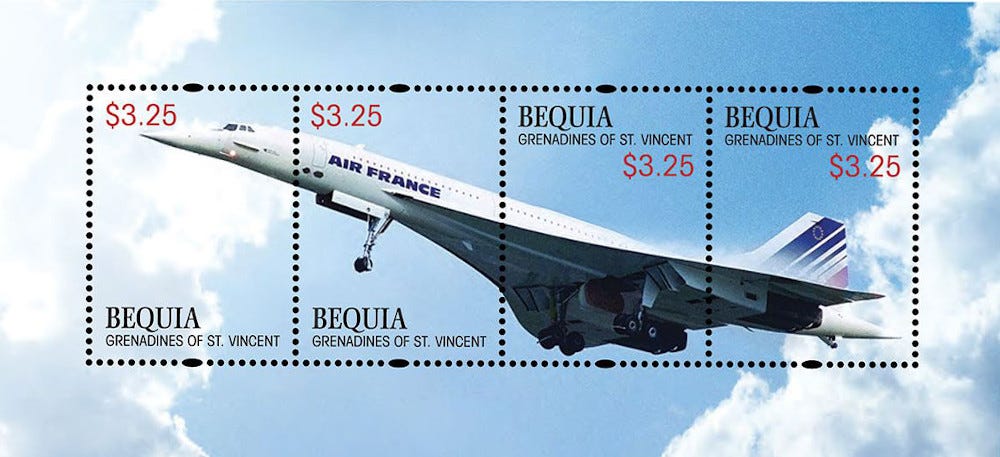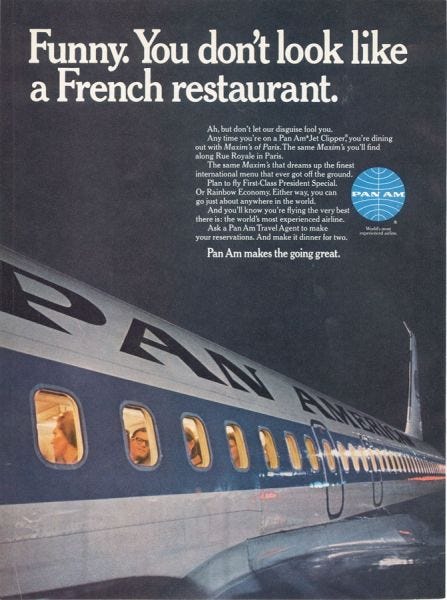Friendly, yearned for skies
We flew to Colorado, probably our last flight if all goes well. Airline nostalgia is much more pleasant than the real thing nowadays. So what?
Read time: about 8 minutes. This week: The workings of nostalgia in the twilight of air travel. Nostalgia may be a lighter form of anger, benign and may even be salvific. Next week: Unread books. Many well-read people have many unread books in their collections. Plus a tour through a very large personal library.

Fly, my thoughts, on wings of gold; go settle upon the slopes and the hills, where, soft and mild, the sweet airs of my native land smell fragrant! — “Va, pensiero,” Nabucco by G. Verdi and T. Solero
After several cancellations and reschedules during the pandemic, my wife and I finally crawled the jetway to fly from North Carolina to Colorado. We hadn’t seen our daughter and partner in ages, and my wife finally said, “I don’t care what happens, we’re going this time.” So we did, and it was wonderful to see the kids and hug them.
Arriving and departing were much less wonderful. As a matter of fact, I’d say so much less wonderful that it was life-changing. After hearing my wife’s story of our return trip, with its travail of the TSA gauntlet in Denver, my son advised, “Live poor. Travel rich.” He meant, of course, to fly first class. I think it would make too little difference overall; and, besides, we have a comfortable car and, most of the time, no rush.
Often — maybe even typically — people don’t change habits because of a big event. A single insult has less influence than a thousand small events, nudging and nudging until you decide to try something different. That’s the process I’ve gone through with air travel, and I had reached the conclusion to avoid air travel long before my wife decided the same thing. The Colorado trip broke the routine; now it will take something very urgent to get us to walk the jetway again.
Air travel has become pleasurable in memory. It isn’t in reality.
“Sir, would you like a bittersweet chocolate chip for dessert?”
If nostalgia were a landscape, among the biggest landmarks — mountainous, perhaps — would be air travel “back when.” Collections of advertisements tell the story, even though the suits of Madison Avenue spun pretty tales for airlines to tell. And yet, the glitz of airline advertising only polishes so much before the shine becomes too obvious. Augmented by memory, however dimmed by years, the glam of magazine glossies let a bit of truth shine through. Things weren’t so bad back then, after all?
Take the butt of many jokes: airplane food. Anyone who has flown a mid-length flight recently has the sense to eat before boarding or to buy, at enormous cost, a middling sandwich to nibble in-flight. Airplane food that comes from the airline? Starvation diet. A symbolic presence on the jet. The food is tasteless, to boot — though part of that might be attributed to dry air and high altitude.
If old ads are to be trusted at all, it wasn’t always that way. In the 1960s, at least, Pan Am claimed to be the Maxim’s of the sky:
Maybe it was true, but through the lens of nostalgia it certainly feels real. In comparison to today’s gourmet delights of mysterious chips and crackers loaded into wrappers that may outweigh their contents, the ’60s Pan Am 707s were indeed Maxim’s on a really good Parisian night.
Pan Am wasn’t the only airline to tout their flying food (here, also parodied for today by yours truly):
Despite the compromises that meal packaging required, the fare aboard a longish flight wasn’t that bad in the last century. Perhaps there is in first class cabins (where available) something resembling food even yet. It’s heartening to know that hot meals were reintroduced for first class passengers on Delta flights about a year ago. But serving a warm meal is a far cry from being Maxim’s.
Still wondering what’s missing today? For a quick comparison, take a look at the second picture in this article to see what Pan Am “economy class” meals looked like in the 1960s.
Nostalgia rage
This past week, as I was writing this post, BBC’s “Worklife” section reported on “Why People Lash Out at Service Workers.” The article shifted my thinking about the reasons for nostalgia, and I suspect now that nostalgia is akin to the kind of anger and aggression that the BBC article examines. Nostalgia is benign, and perhaps even a salve to tensions and frustrations that have grown in the past years; certainly it’s much better than berating an underpaid person manning a phone in a call center.
The article explains that the tumultuous pandemic years are to blame for “lashing out” at service workers, who are particular targets. “It’s possible many still feel robbed by a pandemic that forced us to reschedule life events and deprived us of normalcy, and a wider fury at companies, systems and institutions who don’t seem quite as sympathetic as we feel they ought to be.” And how many of us have yearned for a return to normal, even though pre-pandemic “normal” is unattainable and maybe not all that our memories crack it up to have been. Mental health researchers Kenneth Weiss and Anish Ranjan Dube wrote that “the longing for return to an idyllic or imagined lifestyle has returned amid worldwide quarantining and isolation during the Covid-19 pandemic.” In contrast to earlier psychiatric judgment, they continued, “nostalgia has become a remedy rather than a disease.”
Wistful yearning for a pre-pandemic normal is a healthy nostalgic response.
In the case of air travel, which certainly was upended by Covid-19, the slippage has a longer history; and, if we’re fair, we have to admit that changes in the industry had both positive and negative outcomes. Air travel opened up to many more people as competition drove costs down. Amenities and the caché of flying suffered. Whereas passengers once dressed up to fly — in effect marking the experience as special — today’s travelers do not. Garb of the bus terminal accords with the queues at the airport. A little over twenty years ago, TSA’s insults and theatrics were not a ritual of flying. Nostalgia for the Concorde arises from the aesthetics of the design and its supersonic speeds, but “the Concorde used more fuel to taxi to the end of the runway than a Boeing 737 uses to fly from London to Amsterdam” a BBC article reported. Today’s airplanes are less thirsty, even though their environmental impacts are still worrisomely large.

Airline nostalgia
Pan Am managed to go bankrupt in part because of 1980s deregulation and, probably, mismanagement. I look back on my last Pan Am flight (to Rome in 1989), and if I’m being honest, the trip was a bit ragged at the edges. Pan Am’s ill-health appeared in the plane itself, which seemed to have missed some sprucing up. And yet … and yet, the airline still retains its glow in my memory.
It’s not only me. Pan Am fans have pulled together resources that document the airline’s history and its glory days. For those yearning for Pan Am’s Maxim’s-era airline food, the “Pan Am Experience” offers an opportunity to “Relive the Magic of Flying Onboard a Luxurious Pan Am 747.” It’s an earth-bound restaurant in the Los Angeles area, suitable for LARPing an earlier time of air travel when passengers would be wined-and-dined. The airline was the center of a short-lived television series called, what else, Pan Am. The show drew from Kelly Cusack’s Pan Am memorabilia collection, which amounts to “some 10,000 Pan Am pieces” and is featured at Everything Pan Am.
You have to wonder sometimes if nostalgia can also be passive-aggressive, though Weiss and Dube haven’t yet researched into that area of psychiatry. This may be a malady, if you ask me, mixing up hoarding compulsions, extreme airline nostalgia, and an unresolved inner conflict with airline travel.
An example. You can collect practically anything airline, and not just Pan Am stuff. “MissTWA” even collected images of certain features usually found in the pocket on the back of the seat in front of yours. (“MissTWA … BECAUSE I REALLY MISS TWA AIRLINES!!!”)

Some people are less interested in specific air lines than they are in common features shared by all of them, including the Air Sickness Bag Museum, which has a very usable index of its collection online.
Is this constellation of symptoms a sickness unto itself? But, I guess, I digress.
Got a comment? What are the pieces of information you use to decide whether to get in line at the airport? Are you choosing different destinations than before? Do conditions of air travel influence those decisions? Collected any barf bags lately?
Tags: airline travel, nostalgia, PanAm airline food, barf bag, LARP (live action role play)
Links, cited and not, some just interesting
Wikipedia has a surprisingly detailed entry on Pan Am, probably crafted by the thousands of fans mourning and yearning for the old airline: “Pan Am.” In Wikipedia, July 28, 2022. https://en.wikipedia.org/w/index.php?title=Pan_Am&oldid=1100873743.
Yes, there really is a serious Pan Am Historical Foundation: “The Pan Am Historical Foundation.” PanAm.org. Accessed July 25, 2022. https://www.panam.org/enter.
A video. Evans, Bryce. “Pan Am: A Gastronomic History.” University of Miami MediaSpace, April 18, 2018. https://umiami.mediaspace.kaltura.com/media/Pan+AmA+A+Gastronomic+History/1_mfu9nqht.
Not gonna happen — the return of the Concorde, that is: Dowling, Stephen. “How Do You Bring an Aircraft Back from the Dead?” BBC Future, September 25, 2015. https://www.bbc.com/future/article/20150925-how-do-you-bring-an-aircraft-back-from-the-dead.
Source of the Nabucco quotation at the beginning of this post. The doctors weigh in, just not like it used to be: Weiss, Kenneth J., and Anish Ranjan Dube. “What Ever Happened to Nostalgia (the Diagnosis)?” Journal of Nervous & Mental Disease 209, no. 9 (September 2021): 622–27. https://doi.org/10.1097/NMD.0000000000001349.
Nostalgia is just a more acceptable way to deal with loss of control: Morgan, Kate. “Why People Lash out at Service Workers.” BBC Worklife, August 2, 2022. https://www.bbc.com/worklife/article/20220728-why-people-lash-out-at-service-workers.
An interesting video that compares costs of different kinds of transport, mostly focused on train travel. The cost comparison of air, train, and car travel is interesting, as well as the government actions taken to change transport behaviors. In French, but you can still figure things out, kinda. Zarifi, Elsa Longueville, and Emile Costard. “Les voyages en train sont-ils trop chers ?” Le Monde.fr. July 24, 2022, Online edition, sec. Économie Transports. https://www.lemonde.fr/economie/video/2022/07/24/les-voyages-en-train-sont-ils-trop-chers_6135950_3234.html.




Unless I go overseas, or for a screaming emergency, I doubt I will fly again anytime soon. It has become just simply mind-numbingly painful to fly. People have become such unthinking, unfeeling, and mean-spirited, that I have no interest in subjecting myself to that.
That, and you didn't even call me when you were in town! :-)